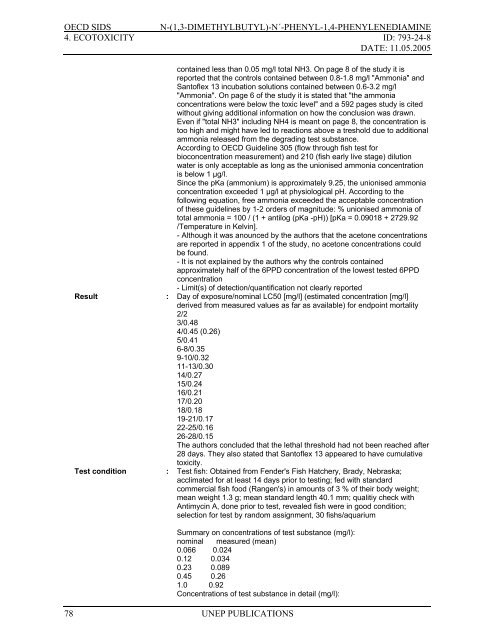N-(1,3-Dimethylbutyl)-N
N-(1,3-Dimethylbutyl)-N
N-(1,3-Dimethylbutyl)-N
Create successful ePaper yourself
Turn your PDF publications into a flip-book with our unique Google optimized e-Paper software.
OECD SIDS<br />
N-(1,3-DIMETHYLBUTYL)-N´-PHENYL-1,4-PHENYLENEDIAMINE<br />
4. ECOTOXICITY ID: 793-24-8<br />
DATE: 11.05.2005<br />
contained less than 0.05 mg/l total NH3. On page 8 of the study it is<br />
reported that the controls contained between 0.8-1.8 mg/l "Ammonia" and<br />
Santoflex 13 incubation solutions contained between 0.6-3.2 mg/l<br />
"Ammonia". On page 6 of the study it is stated that "the ammonia<br />
concentrations were below the toxic level" and a 592 pages study is cited<br />
without giving additional information on how the conclusion was drawn.<br />
Even if "total NH3" including NH4 is meant on page 8, the concentration is<br />
too high and might have led to reactions above a treshold due to additional<br />
ammonia released from the degrading test substance.<br />
According to OECD Guideline 305 (flow through fish test for<br />
bioconcentration measurement) and 210 (fish early live stage) dilution<br />
water is only acceptable as long as the unionised ammonia concentration<br />
is below 1 µg/l.<br />
Since the pKa (ammonium) is approximately 9.25, the unionised ammonia<br />
concentration exceeded 1 µg/l at physiological pH. According to the<br />
following equation, free ammonia exceeded the acceptable concentration<br />
of these guidelines by 1-2 orders of magnitude: % unionised ammonia of<br />
total ammonia = 100 / (1 + antilog (pKa -pH)) [pKa = 0.09018 + 2729.92<br />
/Temperature in Kelvin].<br />
- Although it was anounced by the authors that the acetone concentrations<br />
are reported in appendix 1 of the study, no acetone concentrations could<br />
be found.<br />
- It is not explained by the authors why the controls contained<br />
approximately half of the 6PPD concentration of the lowest tested 6PPD<br />
concentration<br />
- Limit(s) of detection/quantification not clearly reported<br />
Result : Day of exposure/nominal LC50 [mg/l] (estimated concentration [mg/l]<br />
derived from measured values as far as available) for endpoint mortality<br />
2/2<br />
3/0.48<br />
4/0.45 (0.26)<br />
5/0.41<br />
6-8/0.35<br />
9-10/0.32<br />
11-13/0.30<br />
14/0.27<br />
15/0.24<br />
16/0.21<br />
17/0.20<br />
18/0.18<br />
19-21/0.17<br />
22-25/0.16<br />
26-28/0.15<br />
The authors concluded that the lethal threshold had not been reached after<br />
28 days. They also stated that Santoflex 13 appeared to have cumulative<br />
toxicity.<br />
Test condition : Test fish: Obtained from Fender's Fish Hatchery, Brady, Nebraska;<br />
acclimated for at least 14 days prior to testing; fed with standard<br />
commercial fish food (Rangen's) in amounts of 3 % of their body weight;<br />
mean weight 1.3 g; mean standard length 40.1 mm; qualitiy check with<br />
Antimycin A, done prior to test, revealed fish were in good condition;<br />
selection for test by random assignment, 30 fishs/aquarium<br />
Summary on concentrations of test substance (mg/l):<br />
nominal measured (mean)<br />
0.066 0.024<br />
0.12 0.034<br />
0.23 0.089<br />
0.45 0.26<br />
1.0 0.92<br />
Concentrations of test substance in detail (mg/l):<br />
78<br />
UNEP PUBLICATIONS
















